Visit to download the full and correct content document: https://textbookfull.com/product/stone-building-how-to-construct-your-own-walls-patio s-walkways-fire-pits-and-more-first-edition-kevin-gardner/

More products digital (pdf, epub, mobi) instant download maybe you interests ...

How To Build a Sauna Building Your Own Cheap Indoor Sauna From Scratch Like a Pro Victor Allan
https://textbookfull.com/product/how-to-build-a-sauna-buildingyour-own-cheap-indoor-sauna-from-scratch-like-a-pro-victor-allan/

Fire Possessed 1st Edition September Stone
https://textbookfull.com/product/fire-possessed-1st-editionseptember-stone/


Understanding Building Stones and Stone Buildings First Edition J A Hudson
https://textbookfull.com/product/understanding-building-stonesand-stone-buildings-first-edition-j-a-hudson/ mBot for Makers Conceive Construct and Code Your Own Robots at Home or in the Classroom 1st Edition Andrew Carle
https://textbookfull.com/product/mbot-for-makers-conceiveconstruct-and-code-your-own-robots-at-home-or-in-theclassroom-1st-edition-andrew-carle/

Sew Your Own Wardrobe More Than 80 Techniques 1st Edition Alison
Smith
https://textbookfull.com/product/sew-your-own-wardrobe-morethan-80-techniques-1st-edition-alison-smith/

DIY Lithium Batteries How to Build Your Own Battery
Packs Micah Toll
https://textbookfull.com/product/diy-lithium-batteries-how-tobuild-your-own-battery-packs-micah-toll/

How to Start Your Own Business: The Facts Visually Explained 1st Edition Dk
https://textbookfull.com/product/how-to-start-your-own-businessthe-facts-visually-explained-1st-edition-dk/

How to Install Air Ride Suspension Systems Covers
Muscle Cars Street Rods Trucks and More Kevin Whipps
https://textbookfull.com/product/how-to-install-air-ridesuspension-systems-covers-muscle-cars-street-rods-trucks-andmore-kevin-whipps/

Make Your Own Pixel Art Create Graphics for Games
Animations and More Jennifer Dawe
https://textbookfull.com/product/make-your-own-pixel-art-creategraphics-for-games-animations-and-more-jennifer-dawe/



DEDICATION
For Ruth and Derek Owen— Farmers, Teachers, Family.
CONTENTS
PREFACE: WHY THIS BOOK?
INTRODUCTION
CHAPTER 1: Acquiring and Assessing Stone
CHAPTER 2: Site Preparation
CHAPTER 3: The Fundamentals of Dry-Laid Construction
CHAPTER 4: Planning and Designing
CHAPTER 5: Repair and Restoration
CHAPTER 6: Learning Curves of the Self-Taught
CHAPTER 7: Mr. Grumpy Builds Three Walls
CHAPTER 8: Notes on Other Structures
AFTERWORD
FURTHER READING
ACKNOWLEDGMENTS
INDEX
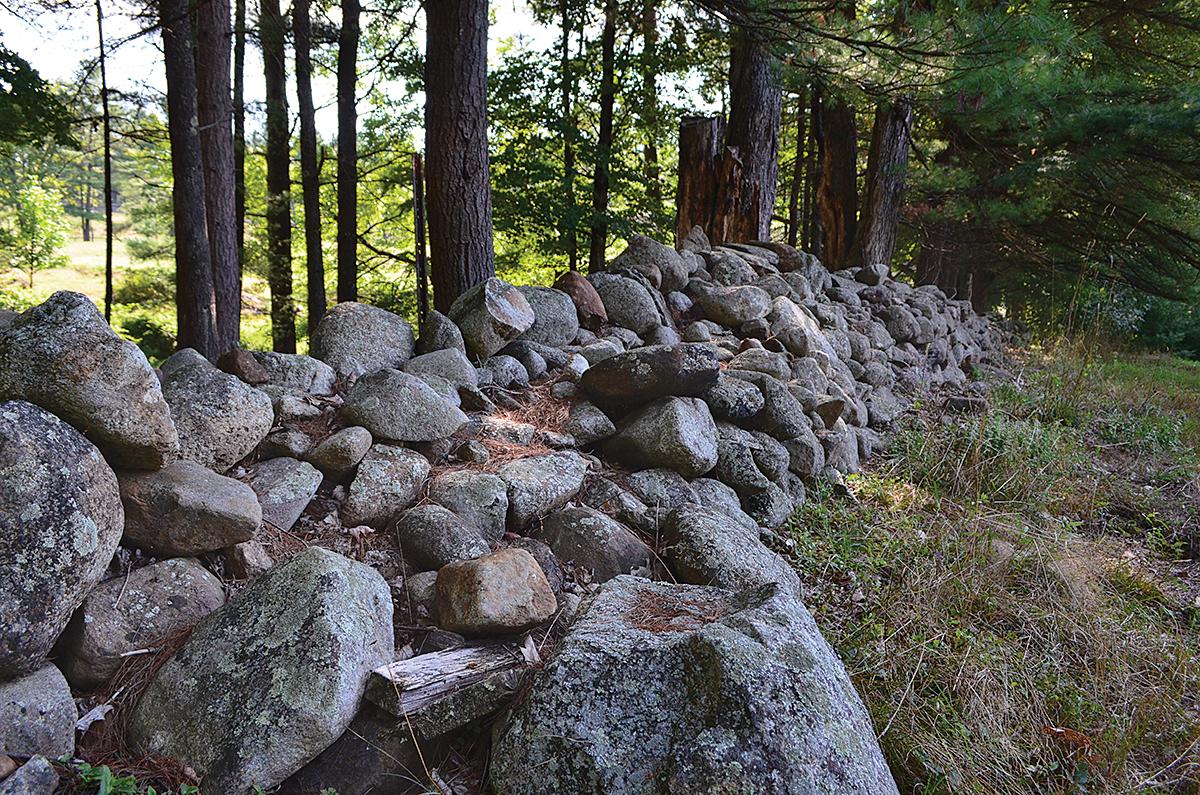
PREFACE
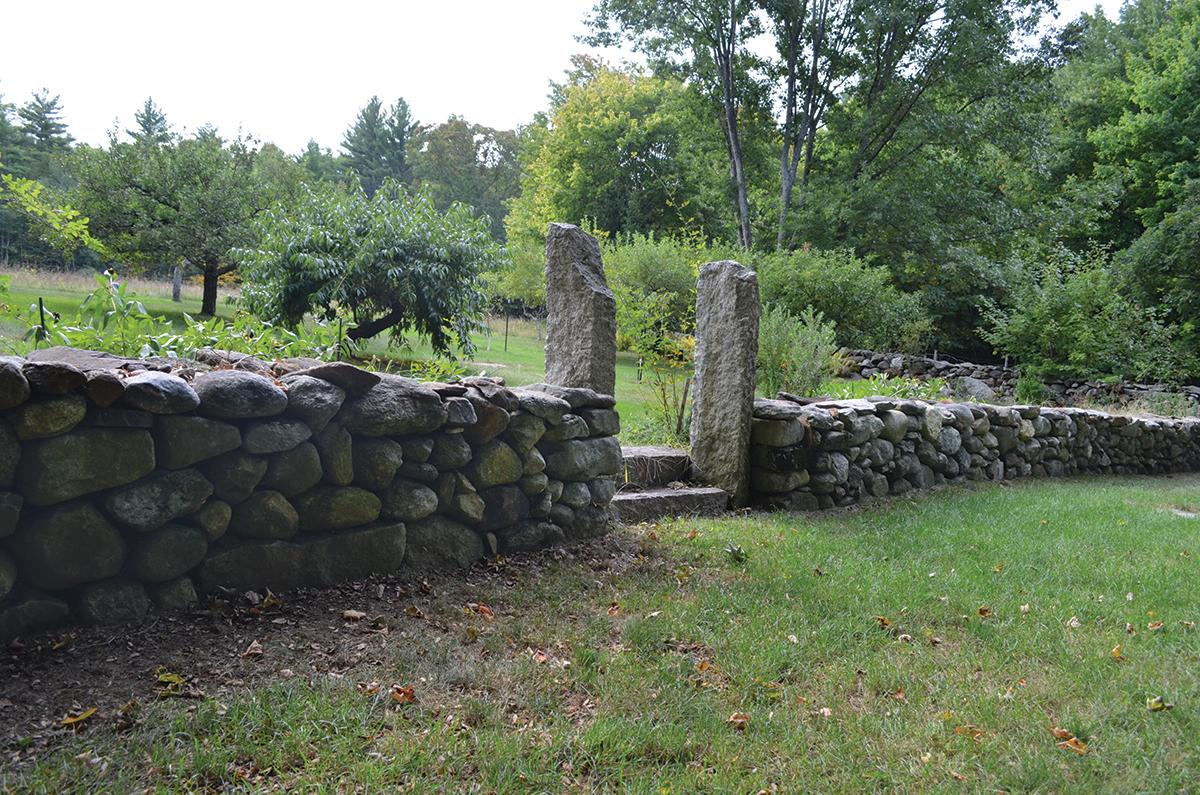
Antique fenceposts anda steppedopening breakthis double-facedwalltogive access to the orchardit helps define.
There is no shortage of books, pamphlets, articles, and online instruction about building things with dry-laid stone. Most of these resources will teach you the basic principles of the craft in a very short time. It’s easy for them to do this because the principles are so simple—and so few. Lay the individual stones of each succeeding course over the joints between stones in the course below. Place each stone in a solid, stable position, so that it cannot rock or shift when touched. Don’t leave unfilled space. Be mindful with each placement of the courses yet to come. Work from the wall to the pile, not the other way around. Build up a project’s interior as carefully as you build up the stones that show, so the structure will be fully self-integrated. And so on.
Tidy photographs or drawings accompany these prescriptions. They invariably show crowds of obedient, well-shaped stones, preselected for their agreeably docile dimensions and easily interlaced in consistently thick, deep rows over one another as though by predestination. Stones such as these make rules like “two over one, one over two” perfectly clear.
But across much of New England, stones such as these do not exist in anything like the quantities that instructional illustrations imply. Instead, they appear with only intermittent frequency among enormous supplies of rounded misshapen lumps, uneven trapezoidal shards, cloven cannonballs, and a thousand other forms utterly estranged from anything to do with flatness or regularity. How, for instance, can you lay “one over two” when the “two” are so dimensionally unlike each another that they can’t offer a shared surface on which the “one” can rest? The essence of New England wall building, then, has little to do with technique itself, which is essentially the same the world over, but with the adaptation of technique to a chaotically obstreperous stone supply that threatens to defeat instructors as readily as it does would-be students of the
craft. “New England’s rounded granite,” concedes one well-known manual, “is a real challenge.” That’s all it has to say on the subject.
Avoiding the complexities of trying to build walls with stones shaped like footballs, eggs, bushel baskets, and asteroids is easier than it used to be. We’re no longer trying to clear off the ground for farming while simultaneously building our walls, so we can afford to select the stones that help and dismiss the ones that don’t. The trouble is that the builders who established the style we’re trying to imitate didn’t enjoy that luxury. Their efforts to use everything that came to hand, to integrate the bizarre with the businesslike, resulted in a distinctly regional style. Those who wish to reproduce that style have no choice but to learn how the old-timers did it if they want their own work to display the traditional, rough-and-ready integrity of the walls that came to define our landscape.
The challenges are equally unavoidable for instructors. A book that attempted to cover every single contingency that could arise when trying to fit New England’s mess of mismatched stone into stoutly coherent structures would be a thousand pages long—and even that might not be enough. Furthermore, the New England style did not simply emerge and remain constant throughout the roughly two-hundred-year period when our enormous network of walls and other structures was largely completed. Beginning in the midseventeenth century as a purely practical response to the twin needs for fencing and land-clearing, it developed by the early nineteenth century into a complex marriage of the useful and the symbolic, a regional specialty that expanded its stylistic range as the tastes, motivations, and objectives of its practitioners also changed. Any instruction in the basics of the style is going to have to take these alterations into account if it hopes to create the fullest possible picture of what can be done with New England stonework today.
This is a book, then, that lays out the familiar fundamentals of wall building—and their regional adaptations—entirely from a New England builder’s point of view. It addresses site preparation, acquisition and handling of materials, construction techniques both general and specialized, tools and equipment, and ways of managing
the learning process. Its illustrations feature typical mixtures of good and bad stone, and they draw distinctions, both technical and visual, among the varied New England sub-styles, from the most primitive to the most discriminating.
The point of it all is to endow you with a sound basis for acquiring the experience that no instruction, however detailed, can provide. There’s no shortcut to expertise in this craft; though the curve may be shorter for some than for others, repetition and practice are the only things that will eventually reward you with genuine skill. This book can point you in the right direction, teach you to avoid wastes of time and energy, and alert you to common pitfalls and dubious decisions. It can show you the difference between a wall that’s built to last and one that is not. What it cannot do is tell you which stone to put where, next. That, you will have to manage by yourself, with your own eyes and your own hands. No two builders, even highly skilled ones, build their walls exactly the same way. Like the dialogue in a Shakespeare play or the language of the US Constitution, the tenets of dry-laid stonework are subject to interpretation, to personal preference, even to the variable dictates of the stone itself. Discovering those things, while also acclimating yourself to the craft’s purely physical demands, the feel and behavior of its materials, and the applied art of seeing what is in front of you, with all its implications and possibilities, is ultimately a process of self-teaching. In New England, where every stone wall, however modest, and every builder, however inexperienced, joins a glorious tradition, these discoveries are only part of your reward.
INTRODUCTION
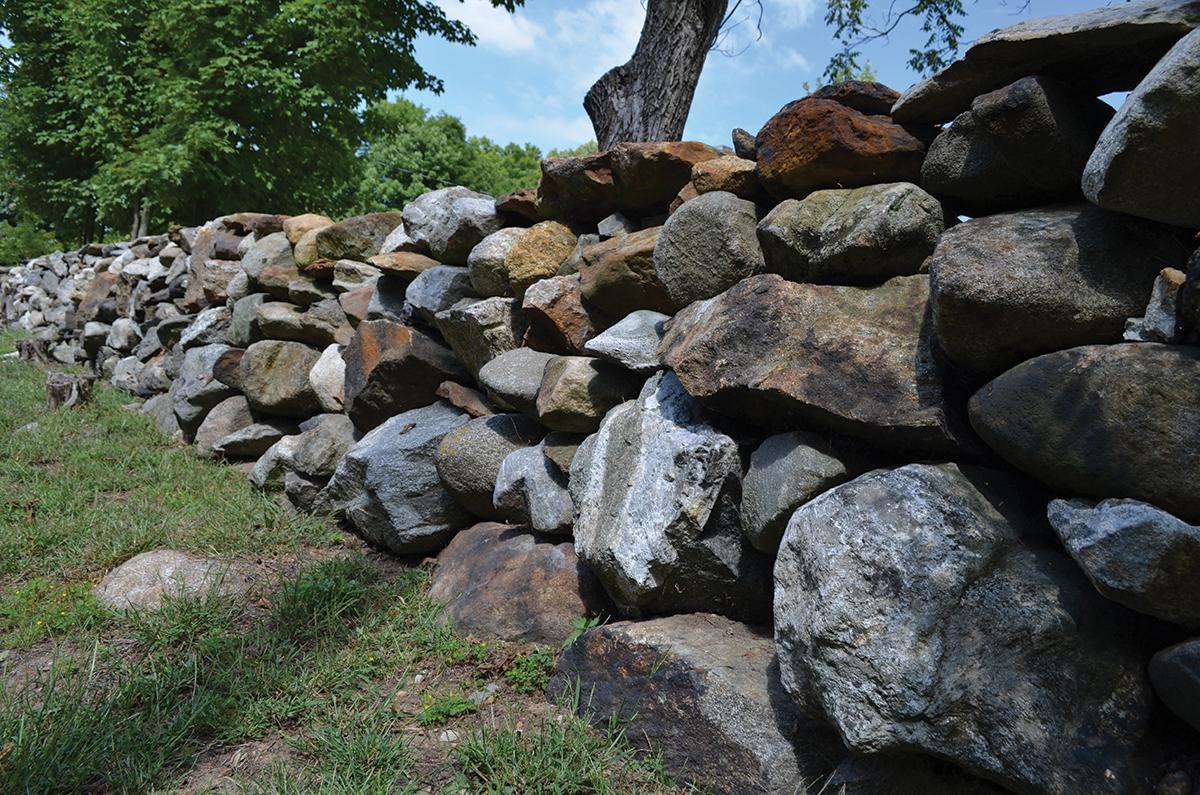
The raggedsurface ofa restoredsingle-stackwallmakes a forbidding barrier.
“Please don’t make it look too nice!”
During my forty-plus years of stone wall building here in New England, I’ve heard this request from customers more than once. At first it sounded a little odd. After all, is this a thing you would ask the contractor who comes to remodel your kitchen? Or the one who paves your driveway, or paints your house? I joke about it in the talks I give on the craft of traditional New England dry masonry: how it caused my family and me to teach ourselves to build walls that appear to be on the verge of collapse but are actually quite sound. It is, I announce ironically, a circumstance unique in the history of the building trades. Why would anyone wish to spend good money on deliberately primitive, almost haphazard work?
But my customers are not asking for shoddy construction. They are asking for authenticity, for stonework that resembles and recalls what they see around them every day across the famous New England landscape. They use the word nicenot synonymously with agreeable,attractive, or pleasant—qualities they strongly favor—but in an older sense, meaning fastidiouslycareful,delicate, precise, or overlyrefined. Too much of this kind of nicelooks wrong to them, like a farmer mowing hay in a tuxedo.
Part of their preference is conditioned by observation. The old walls we’re so used to looking at are largely unmaintained, and therefore doing what people themselves do as they get older: spreading, relaxing, falling apart by slow degrees, returning to the dust. But more of it is intuitive, because even in a deteriorated condition, New England’s traditional stonework has a kind of perfection. It is a perfection of consistency, utility, and persistence, not of finesse or even always craftsmanship. In spite of the semiruinous condition of so many of the region’s antique walls, they continue to fulfill at least part of their function: to serve as storage structures for uncountable tons of random glacial detritus that would
otherwise make farming—and a lot of other things—exceedingly difficult in the northeastern United States.
This fact points to the very thing that makes New England walls distinctive in the world of dry-laid stonework. Their authenticity doesn’t come from discrimination but from inclusiveness. The farmers who built most of them were far more concerned—at least at first with clearing the land than with artful fence-making. Rather than selecting cooperative, well-shaped material from the formless mess of rubble they hauled off their fields and pastures, they made an effort to use as much of it as possible in the walls, wells, culverts, causeways, bridges, and foundations they erected by the thousands across the region.
In doing this, New England’s original wall builders created a style. It is often rough, unnecessarily bulky, not overly concerned with flat or tightly fitted faces and surfaces. It does not assign position according to stone size, but tends to use all sizes in all parts of the structure. It employs numerous tricks—trapping, back-shimming, compensation, overbuilding—in order to dispose of huge amounts of junk stone in structures primarily built for longevity rather than artifice. Modern day observers might be forgiven for concluding that these early builders didn’t care very much how their walls looked so long as they did their jobs.
Dumped, thrown, tossed, stacked, laid
The evidence suggests this is not true. Good-looking walls make a good-looking farm, and good-looking farms say something about their proprietors’ personal qualities, both as farmers and as citizens. Given the circumstances under which the majority of New England’s stone walls came about, perhaps we should reconsider what “goodlooking” really meant to the eyes of their builders and original
beholders. Like the walls themselves, perceptions of their handsomeness have changed in the 350 years since we started building them.
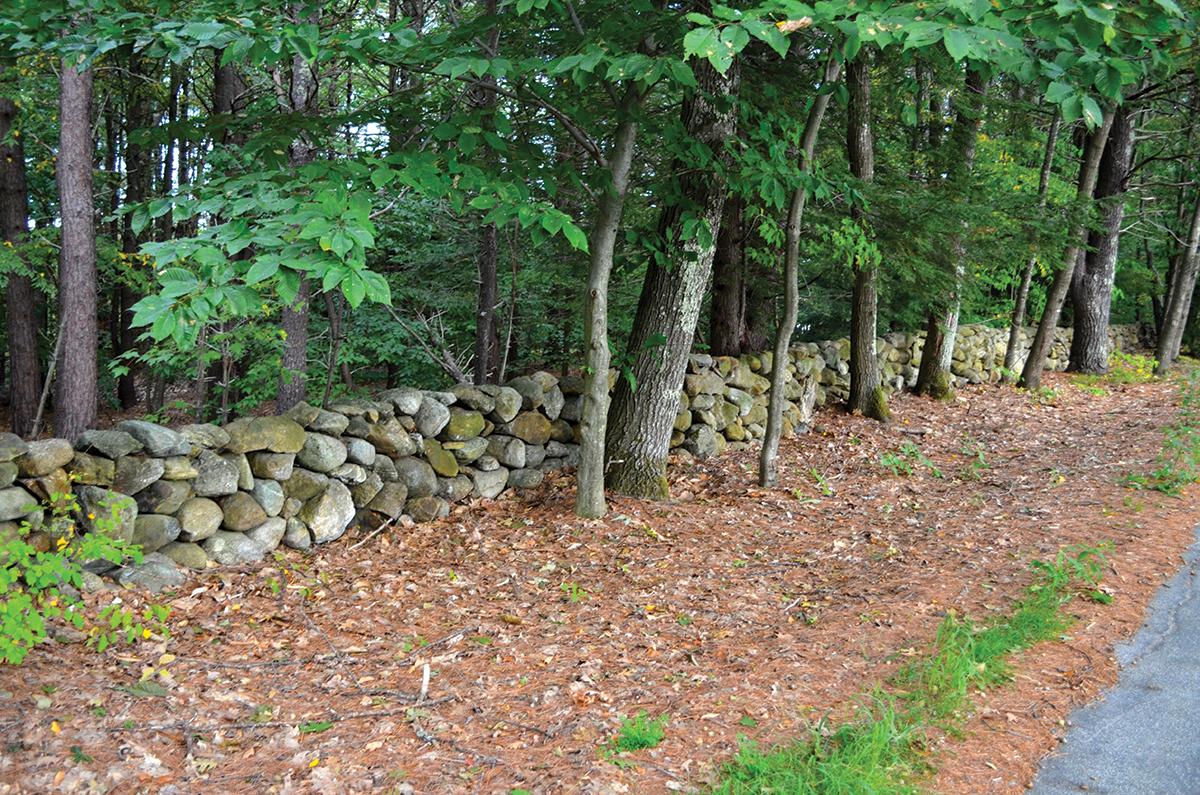
Single-stackwalls were often constructedalong roadsides.
New England’s agricultural landscape was created out of nothing. Whether on the rocky promontories of the Rhode Island coast, in the fertile floodplain of the Connecticut River Valley, among the rollercoaster hills of central Vermont and New Hampshire, or in the vast forested spaces of inland Maine, our first farmers entered the “howling wilderness” of the Puritan imagination made manifest. This was not, to them, a human place, but a godless chaos of ungoverned fecundity, extreme weather, and heathen inhabitants. It had to be tamed in order to become the home of decent Christian people. This idea took hold so powerfully that, even two centuries after the first white settlers arrived, one of the most iconic subjects of nineteenth-century landscape painting remained the rude log cabin, dwarfed by an overwhelming scene of wooded mountains and
trackless vistas, yet snug in its little stump-pocked clearing, reassuring smoke rising like prayers from its humble chimney.
Sometimes there is a fence in the picture. Usually of pulled stumps or split rails but now and then of stone, it is one of the scene’s most important elements. Separating the safe, cleared space from the feral, threatening woods, it is the tamer, the wall of civilization holding back the unholy disorder beyond. In a scene like this, the beauty of a wall, whether of stone or anything else, is that it exists at all. We know the scene will change. The house will grow larger, less primitive; the clearing will expand in all directions; fields of stumps will become grass or plowed acreage; barns, sheds, and even silos will appear; there will be a road someday. But none of these things will mark the place settledas clearly or as immediately as the fence. It is the earliest and strongest claim on the land itself. It was this aspect, the part walls played in the larger picture of wilderness transformation, that mattered far more to their first makers than relative degrees of craftsmanship. In this context, roughness is both acceptable and expected.
When we look at this picture, we also see its future. In time, there will be more walls. Perhaps of rails at first, but later of stone, they will grow as the homestead grows, with the same increasing attention to the details of their quality that we’ll see in the buildings and on the ground itself. Roughness will remain the calling card of some, but in others we will see a finer sense of form and pattern. As the context in which a wall becomes “good-looking” begins to change, so do the walls themselves.
Commentators as diverse as Eric Sloane and Robert Thorson have pointed out a definite arc of development in the technical sophistication of New England stonework, from the “dumped” wall (unplaced linear mounds) to the “thrown” or “tossed” (rudimentary placement of outside surface stones but a dumped interior), to the “stacked” (relatively careful outside placement, more verticality, partially placed interiors), and on to the “laid” (careful selection and tight placement of outside surfaces, consistent dimensions from end to end, through stones for stability, fully placed interiors with little
free space). These distinctions point to phases of preference in wall building that reflect a similar progression in land development, from the primitive struggles of wilderness survival to the settled tidiness of farms and villages in New England’s agricultural halcyon days. It’s even been speculated that identification of the above types can be used to date wall construction in a given area.
But the story is more complicated than that. First of all, the “types” are nowhere near as pure as their descriptions make them sound. Combinations of partially thrown and partially stacked walls abound. Either of these can easily collapse into shapeless mounds over time, thus looking more dumped than stacked. Laid walls can have loose, sloppy interiors that accelerate their deterioration, or may morph into more primitive types as soon as they pass out of sight of the house. Many walls have loosened up so much, been extensively pilfered or absorbed so deeply into rising forest floors that it’s no longer possible to tell what they were when first constructed. Furthermore, because the New England countryside was settled for farming not all at once, but by long degrees over many years, it is likely that lengthy stretches of time passed during which all these types were under construction somewhere, simultaneously. The staggered time frames of settlement, as well as the ways the types can blend into one another, make over-reliance on categorization a bit rigid. Satisfying as definitive nomenclature can be, it does not always accurately capture the reality on the ground.
Nonetheless, over more than 350 years now, the general evolution of New England stonework has followed a more or less steady path from the practical to the decorative. Modern day builders, even those in the restoration business, almost always emphasize form over function, the opposite of original attitudes. The growing professionalization of the craft after about the midnineteenth century had something to do with this shift, as did the fresh infusion of traditional skill that arrived with immigrant stonemasons between then and the early decades of the twentieth century. Perhaps most significantly, stone wall building ceased to be
an ordinary chore practiced by thousands, and became instead a specialized occupation pursued by a self-selected few. Once farmers stopped building and maintaining their own walls, knowledge of the craft began to confine itself to a much smaller group of people. In 1871, the US Department of Agriculture published a study that found more than two hundred and fifty thousand miles of stone walls in the northeastern United States, the majority built by about eight generations of farm laborers, to whom wall building was deeply familiar, if not a profession. Yet just four generations later, in 1971, Curtis P. Fields could publish a book titled TheForgottenArtof BuildingAStoneWall, evidence enough of how quickly a onceordinary chore had become a mysterious “lost” skill.
Fields’s book, like the earlier USDA study, appeared on the cusp of a new era. But whereas the Department of Agriculture’s Statistics ofFencesintheUnitedStateswaved goodbye to the great age of vernacular dry-stone construction by taking inventory of what had been accomplished, TheForgottenArtsignaled a new enthusiasm for stonework by lamenting what had disappeared. Printed just as fresh waves of residential construction began to wash over New England’s old farming landscapes, Fields’s work was one of the first glimmers of a renaissance that today finds many more people engaged in wall building than at any time in the last century or so.
Many of these new builders are professionals, working for landscaping companies or on their own. Some are all-purpose masons, and some specialize in dry-laid work. But almost all of them are oriented stylistically to what our customers think of as the “modern” look, a carefully selected, straight-line, paper-smooth pattern that seeks to make fieldstone behave with the course-bycourse regularity of brick or block. Their walls are finely flattened, squared-off, and very tight, not at all reminiscent of the improvisational randomness that characterizes the region’s original stonework.
These are the walls that look “too nice” to be authentically New England. Although they are well-built and attractive, their fussy selfconsciousness is unsatisfying to those who appreciate the deeper
New England landscape: the worn, experienced, even partly tumbled structures that seem almost to emanate from the land rather than impose themselves upon it. Thorson has called them “landforms,” a term that nearly implies they are natural features of the topography rather than anything made by humans. The ubiquitous persistence of so many of them in areas where people haven’t lived since the middle of the nineteenth century supports this interpretation, especially in the eyes of visitors. “Why did they build all these walls in the woods?” they often ask. They are surprised, even skeptical, when told the woods were once open fields and pastures. The notion that the stone walls are older than the forest seems backward.
In a way, it is. The walls, after all, once replaced the woods, back in the days when both were newly laid down. But when the woods returned, the walls remained, transformed not only by age but by seniority. Formerly the emergent markers of a new world, they are now the weathered legacy of an old one, valued as much for what they remember as for what they are. This is why building and restoring them today not only honors the past but explicates it, creating a continuity of experience that strengthens our shared sense of place in spite of the enormous differences between our lives and those of the walls’ originators. To build a stone wall in New England today is to vastly sharpen your appreciation for the accomplishments of our predecessors, whose unmechanized dedication achieved results that seem practically impossible even to those who study them closely.
It’s also why so many inspired amateurs have taken up the craft. Whether rehabilitating old work on former farmland or building new landscape walls in more developed areas, they have discovered that traditional stonework is far more than unmitigated drudgery. While it certainly has its moments of tedium and frustration, it also offers meditative solace and great satisfaction to those whose temperaments allow them to stick with it through the early learning process. Working for the most part without formal instruction, sometimes for many years, avocational wall builders have become
significant contributors to the New England tradition. I have been impressed time and again by the quality of their work, which proves better than any other evidence that drystone construction is no arcane mystery but a skill perfectly accessible to almost anyone fortunate enough to have functioning hands, legs, eyes—and patience. Many amateur builders describe walling as a kind of addictive pleasure, one they return to over and over as new projects suggest themselves or old ones cry out for repair. One can only imagine how our exhausted ancestors would feel to learn that the enforced toil of their own time has become a form of recreation for another.
“Use it up, wear it out. Make it do, or do without.”
I learned this aphorism from my mother, who grew up on a little family farm during the Depression and World War II. A determined commonplace among people who lived in a time of scarcity and rationing, it also captures something essential to New England’s rural character, and, by extension, to its stone walls. Is there a soft spot on that apple? Cut it out and eat the rest. Did the eyelet for the gate-hook break? Drive a nail into the post and hook it over that. Need a sledge to haul some stone? Use the hood from Uncle Jake’s old station wagon. Save everything. Waste nothing. Never buy when you can improvise. The poet Donald Hall discovered perhaps the greatest expression of this attitude when he was cleaning out his grandparents’ New Hampshire farm and ran across a glass jar full of tiny bits of twine. The label on the jar said “String Too Short To Be Saved,” a phrase so drily pithy that Hall used it as the title for his book of youthful memories. His poet’s ear undoubtedly responded to the contrariness of it, and perhaps even to the fact that, pronounced with a New England accent, the word shortsounds like shot, an
idiomatic adjective that means defunct,wornout,usedup. On a jar full of saved things not worth saving, even the label is made to do double duty.
It isn’t a long leap from stringtooshorttobesavedto stonetoo worntobeused. The mixed sense of frugal sufficiency, wry selfcontradiction, and even pride that underlies Hall’s wonderful title shows itself in New England’s stone walls as well, not as words but as pattern, proportion, and practicality. In spite of their apparent randomness, our walls are the creations of a sensibility that takes a clear look at its surroundings and devises ways to get along without dependence on anything manufactured or imported, but by simple rearrangement of what is already at hand. “If I ever go looking for my heart’s desire again,” says Dorothy at the end of TheWizardof Oz, “I won’t look any further than my own back yard.”
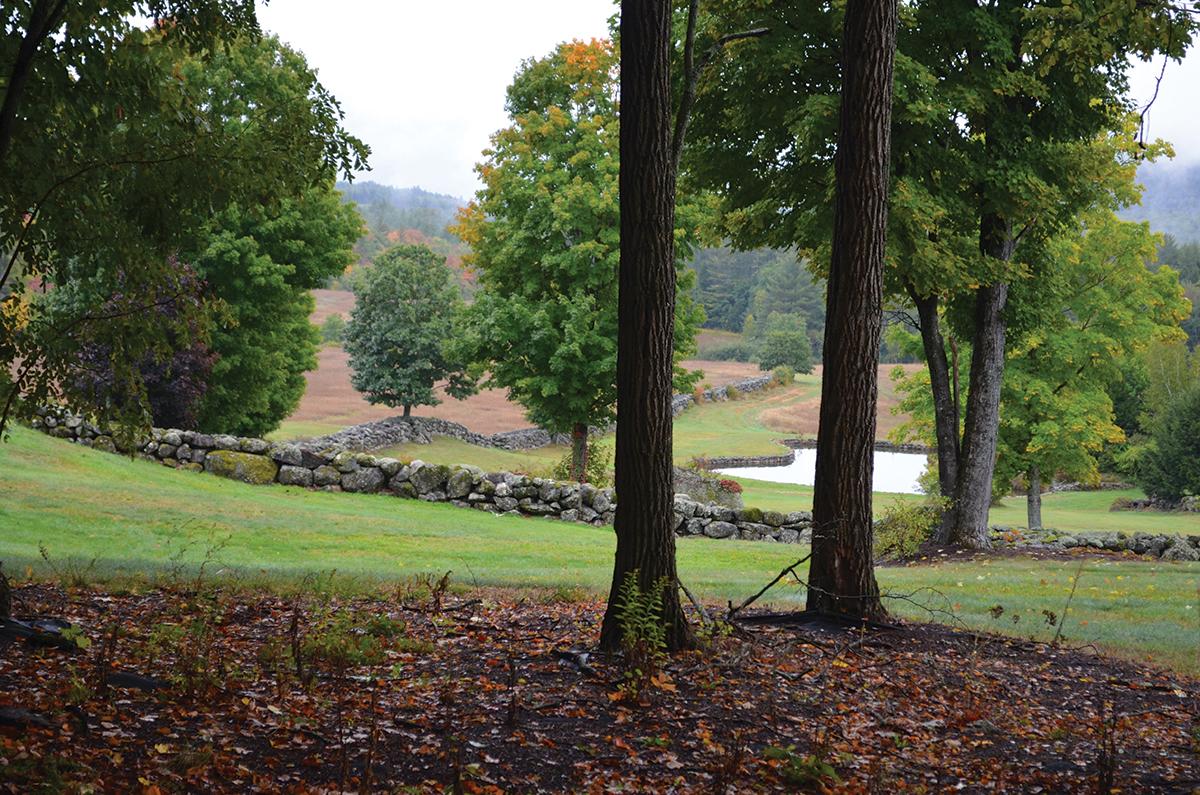
The stone walls ofthe Northeastdefine the region’s oldfarming landscape as deeply as ever, over a century anda halfafter mostofthem were built.
The old style doesn’t put on any airs. It uses what it finds in its own back yard, adjusting its dimensions and its appearance to make itself a haven for large amounts of stone that fancier work disdains. It ages more gracefully than that work because its tolerance for eccentricity in form and fit allows it to absorb the numerous minor disturbances that accumulate in all walls over the years much less noticeably than tighter, flatter structures can. Although it requires a certain degree of craft to ensure its stability and its longevity, it does not seek to display that craft in showy or artful patterns. It lets the stone, not the builder, do the talking. This is how people made stone walls when it was ordinary work for all, not a special skill possessed mostly by elite professional custodians of its secrets. Its vernacular anonymity makes it look old even when it’s new, and because of this it’s right at home in almost any part of the region. This is New England, it says, where we make it do even when it’s not too nice.
CHAPTER 1
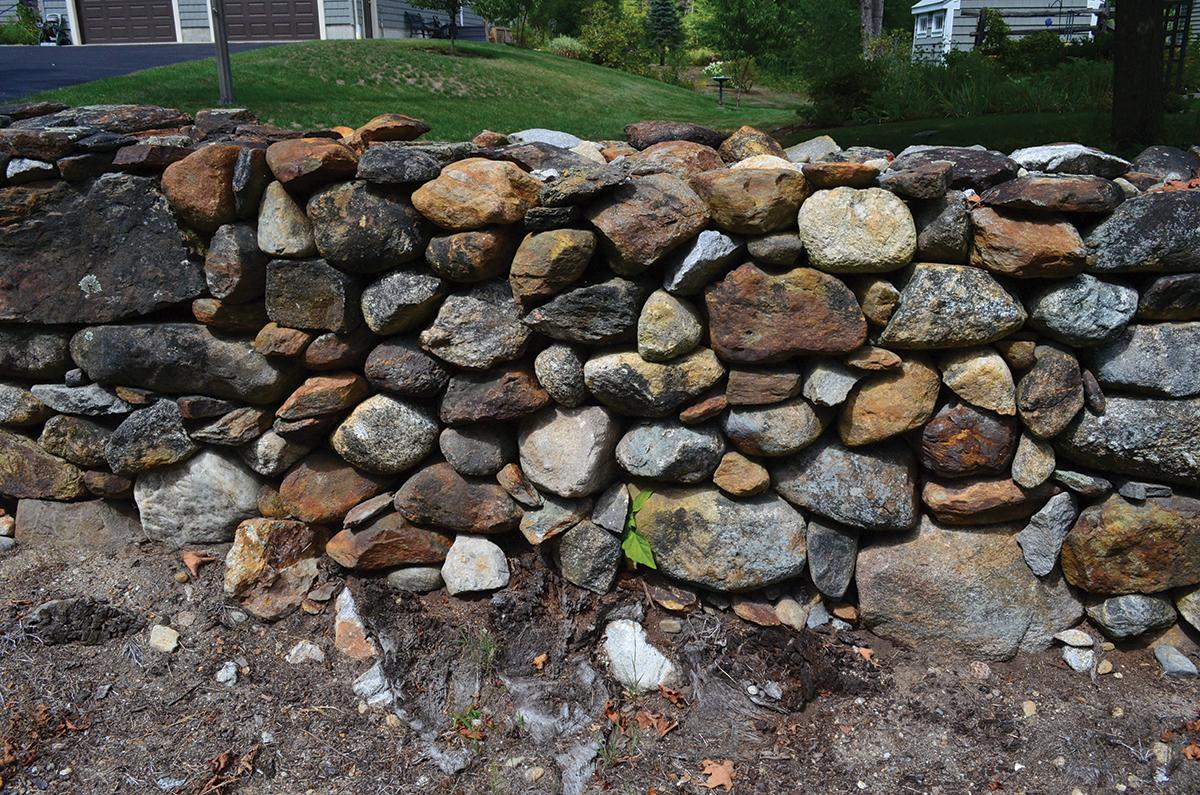
The roughtraditionalface ofthis double-sidedfreestanding wallincorporates a variety ofshapes andsizes.
Acquiring and Assessing Stone
The business of acquiring stone for the project you have in mind has become more involved than it once was. Builders of forty or fifty years ago commonly ranged along the country roads of New England, helping themselves to any old tumbled wall they came across as long as it wasn’t in the front yard of an occupied home. This is one of the reasons not a few of our rural roadside walls are now so much reduced in size—many to only a third to half their former heights. Nowadays, most local builders don’t practice this sort of casual theft as heedlessly as their grandfathers did, but the ‘igneous larceny’ (in my brother Chris’s delightful coinage) continues, if anything more robustly, and even systematically, than before. This is because weathered New England fieldstone, the kind you can only get from antique walls and other structures, has become such a valued building commodity. In great demand for everything from fireplaces to hardscaping to the decorative and sitting walls around gardens and patios, the stones from our old network are showing up in all kinds of new places—some of them far from New England.
Efforts to stop the outright theft of stone have been slow to begin, but they have been gaining traction in recent years thanks to the work of activists such as Robert Thorson and various local organizations, and to increasing public awareness that the walls from which these stones are taken are important parts of New England’s cultural heritage—besides being someone’s property!
Fortunately, there are plenty of ways to get the stone you want without stealing it. The first thing to do, however, is to determine what kind of stone that is, and how much you really need.
Picking a stone type is partly a matter of aesthetics and partly a matter of structure. Stone dealers in New England now offer a variety of types, in different colors, shapes, and average sizes. Some of these are not from New England, such as Corinthian from upstate
New York, or the popular Pennsylvania Flat. These and other imports make perfectly functional wall stone but will not produce the traditional New England appearance. Even weathered old stone acquired legitimately (one hopes) within the region has usually been graded according to average size, and so it is less randomly shaped than a true run of native material, though its colors and surface textures are more familiar than stone from other regions.
Your choice of stone type shouldn’t just be influenced by personal preferences for color and texture, however, but also by what it is you’re going to build. Straightforward double-faced freestanding walls need lots of good face stones, longer than they are wide, with at least one end that’s relatively flat. Retaining walls need fewer of these, and can often be counted on to absorb large amounts of poorly shaped or rounded stones that aren’t much help in the wall’s face. Steps, butt ends, and corners require considerable numbers of stones with ninety-degree angles to them, some in rectangular or square form at thicknesses up to six or eight inches. Single-stacks call for supplies of larger stones in general, as many of them as possible in shattered, elongated, or multi-angular form, with very few rounded bushel-baskets or cannonballs. Larger, thicker walls eat up more volume, and so can stand stone supplies that are not as rich in the most helpful shapes. Shorter, smaller walls need larger quantities of cooperative building stone because they have less interior space in which to stash the junk.
When you buy stone from a dealer, most of what you’re paying for is the cost of gathering, palletizing, and transport. Dealers are selling convenience as much as the material itself, and this creates markups that can make it formidably expensive for large projects. Purchased this way, weathered New England fieldstone can end up costing as much as six hundred dollars a ton, meaning that fifty feet of two-by-two garden wall may require an outlay of nine thousand dollars or more, just to put its approximately fifteen tons of stone on your site.
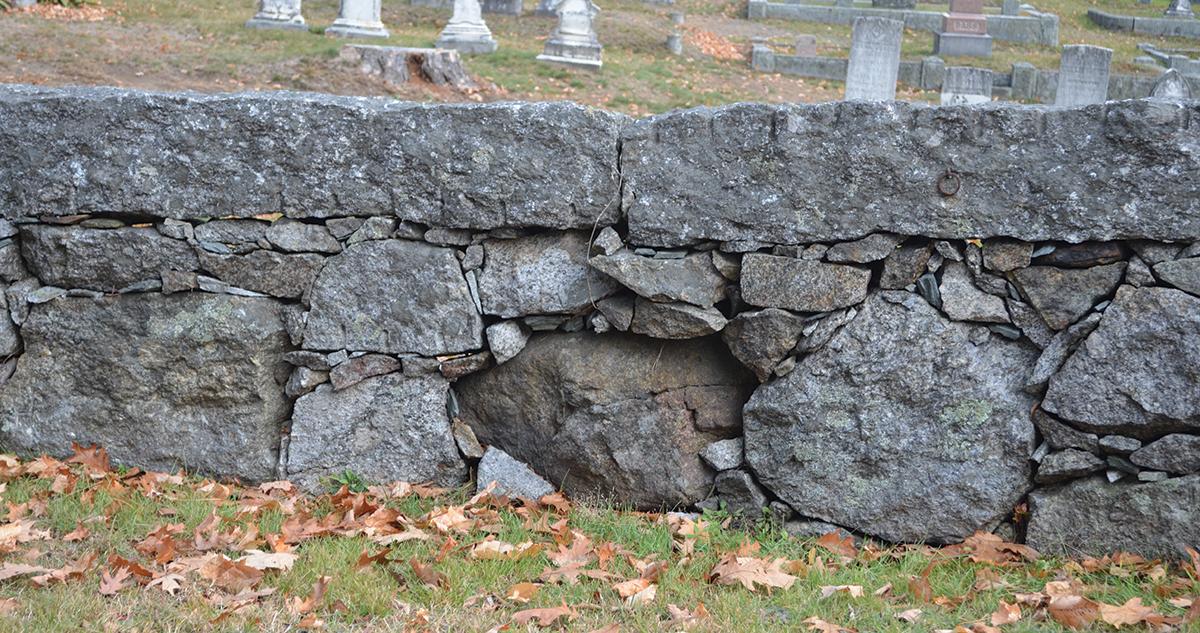
Alone naturalboulder foundits way into this cemetery wallotherwise composed ofrough-splitblocks.
Fortunately, there are alternatives, especially if you don’t mind a little legwork. Stone yards, landscape materials dealers, and other retailers will sometimes share information about their sources, allowing you to skip a step in the markup chain for large quantities. Construction companies doing major excavation projects occasionally sell off piles of blasted rock from their job sites. Active quarries may allow you to hand-pick loads from their immense heaps of tailings for a flat per-load sum.
But if the old weathered stuff, in all its wild random glory, is what you’re after, the best way to find it is to make contact with a member of the class of people who possess most of it: private landowners.
This can take some time. Many New Englanders who own land in old farming areas have miles of crumbling walls, abandoned foundations, or even large dumps of discarded stone never used in any structure. While some are uninterested in selling it, others are quite willing to listen to your offer. I know this because I am regularly approached by them at my lectures; ironically, they’re often unsure how to go about locating a buyer for the stone they’re
interested in selling. So this is a case in which both the supply and the demand exist, but without an established market to connect them.
Naturally, opportunities to locate stone supplies are likely to be more numerous the farther away you travel from urban centers. In small towns, sources of information include road agents, mason and landscape contractors, and excavation companies. You can place ads in local papers, post “Will Buy Weathered Fieldstone” inquiries on the bulletin boards at village stores, or spread the word through people in the area you may already know. You can conduct searches on the Internet, too, which may turn up all kinds of surprising opportunities. When you locate a possible supply, you should do three things, in this order: Go and look at it, agree on a price, and arrange for transport.
Look Before You Buy
It’s a bad idea to buy any stone you haven’t seen. I did this just once, in youthfully ignorant days, and ended up with a ten-wheeler load composed of two-thirds useless bowling balls and one-third dirt because the seller had loaded it directly from the source with a machine instead of hand-picking it. I didn’t look, I didn’t ask, and as a result I acquired a large pile of lousy stones and a whole lot of really expensive forest loam full of leaves and sticks.
The best situation is one in which the landowner allows you to pick what you want from the wreckage of an existing wall or foundation, or from a dump. Sometimes sellers will stipulate that you remove the entire section, wall, or pile. Even today, farmers are still dozing or burying walls in order to enlarge fields, and developers are removing them to open up sections for house lots. In these cases it’s wise to be sure you’ll be able to use all that you take, or most of it. But what exactly is it that you’re looking for?
Viewing a raw supply of stone with an eye to what you intend to build means classifying its types according to approximate percentages: how much of it is rounded and relatively smoothsurfaced? Is some of it roundish, but rough and abrasive? How much of it, if any, is flat? How much is broken, shattered, or otherwise angled, sharp-edged, or squared off? Is there a healthy percentage of stones that are longer than half the width of your project? What about small pieces, the chips, shards and angular chunks so useful for filling odd spaces and pinning the bottom sides of overly-rounded builders? It’s not necessary to quantify these types by strict numerical calculation, only to note the relative amounts of useful (the flat, the long, the square, the angular, the roughly-surfaced) and difficult (the smooth, the round, the lumpy, the rotten) material in the supply as a whole.
Emphasis in collection can change according to the kind of wall you intend to build, as noted above. But in general, a productive supply of material for most standard applications in New England wall building includes all the shapes and attributes mentioned here. Variety in selection actually improves your chances of creating a sound structure because it ensures you’ll have variant solutions for the variant difficulties in fitting that inevitably arise. It is often more challenging to build with stones that are all more or less the same than with those that have a wide range of different shapes (unless, of course, they’re all flat). This is especially true when too much of your supply is rounded off or worn to smoothness. Many projects can be made to absorb sizeable quantities of this kind of difficult stone, but if, say, more than a third of it runs to the spherical, you’re going to have a tough time making use of it all. As to average size, it’s a good rule of thumb not to bother with individual stones that are larger than half the height of the wall you’re proposing to build. Unless you’re going to hide them within the wall’s interior, they’ll look out of proportion in the finished project. There are exceptions to this, of course: particularly alluring surfaces or mysterious shapes, flattened rectangles or squares, or boulders used as end stones.
In almost every kind of dry-laid wall, however, the most important stones are the ones we call builders. Without an adequate supply of these, your experience with any project is bound to become a miserable one, sooner or later. Builders are the stones that show, the ones that make up most of the containing outer faces, or ‘skin’, of the wall. They have three essential qualities: a shape that permits them both to perch soundly in their chosen spots and to offer stable platforms for the stones to come, enough length to pass back into the wall’s interior in order to be properly gripped by its mass, and a face that is, if not necessarily flat, at least broad enough to allow the edges of adjacent faces to meet it laterally without leaving unsightly gaps. Ideal face stones, then, often tend to be shaped more or less like loaves of bread. See the top photo on the following page for a group of good-looking ones.
The bottom photo on the following page shows a group of face stones that appear to be useful, but each has a serious flaw. Looking from left to right, the first is blocky and almost square, but also too shallow. It can be used, but should be laid in between two others that are good and long, so that it will be less likely to be squeezed out of place as the wall settles and ages. The next has a striking triangular face with sheared straight lines, but it tapers so radically from front to back that it’s likely to be spit out of the settling wall very soon in the structure’s life, like the flesh of a grape being squeezed out of its skin. Its smooth surface will accelerate this process. Number three has a rougher surface that will grip other stones more firmly, but also tapers far too much from front to back. Numbers four and five have plenty of proportionate length and workable faces, but are broader in the middle than at their ends, a shape that will create ugly clefts in the wall’s face when laid beside other, straighter stones. The sixth is mighty tempting, but its face is on the long side, not the end, and so very little of it will be gripped in the wall’s heart. When things begin to loosen up, it’ll be one of the first pieces to go. The last two have good length and bulk, but both have upper surfaces that angle down at the facing ends, and so
they will not support the outer edges of any stones laid on top of them, soon threatening to spill them out. We call them skijumps.
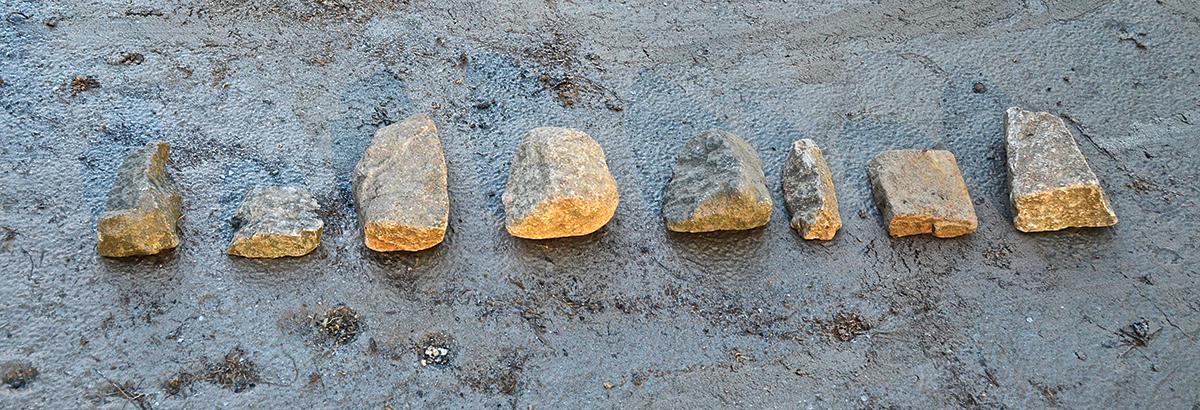
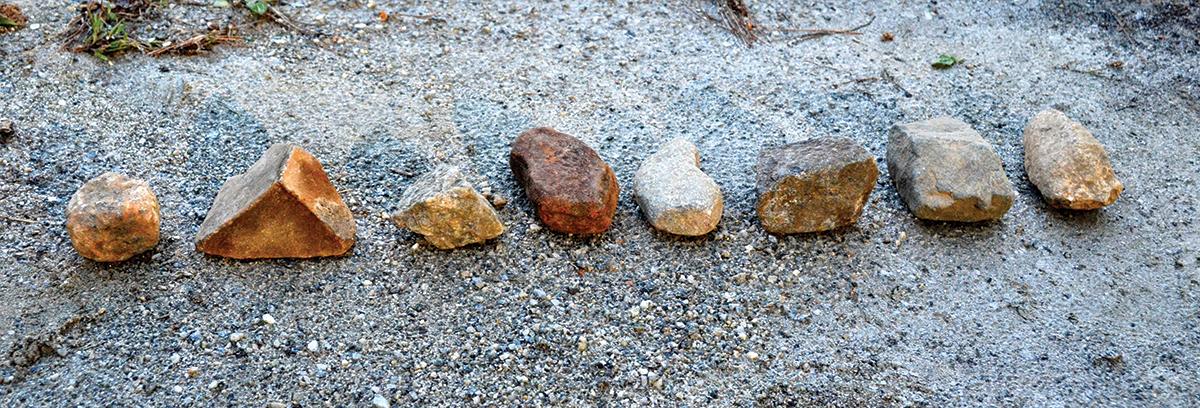
Pay What?
With commercial dealers, prices are generally fixed, but when you bargain with a landowner, you’ll have to work out something acceptable to both parties. We’ve typically paid about sixty dollars a ton for good weathered building stone when we have to pick it and transport it ourselves, but over one hundred dollars—sometimes well over—in cases where the loading and hauling were done by others. A ton of stone isn’t very much. Twelve to fourteen one-cubic-foot blocks of granite will weigh close to two thousand pounds, an amount that if stacked together will make a solid unit six feet long, two feet wide, and two feet tall, with another one or two blocks
Another random document with no related content on Scribd:





